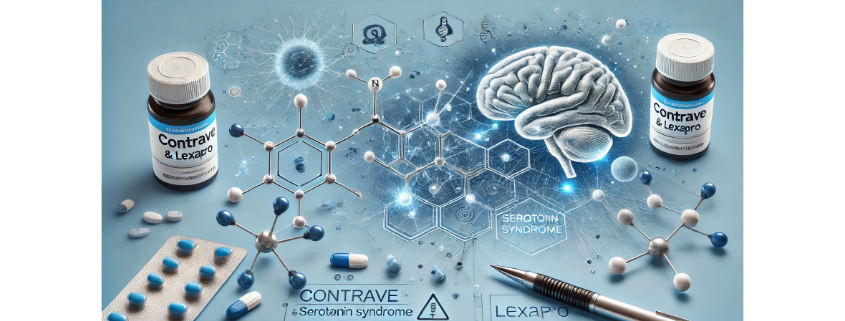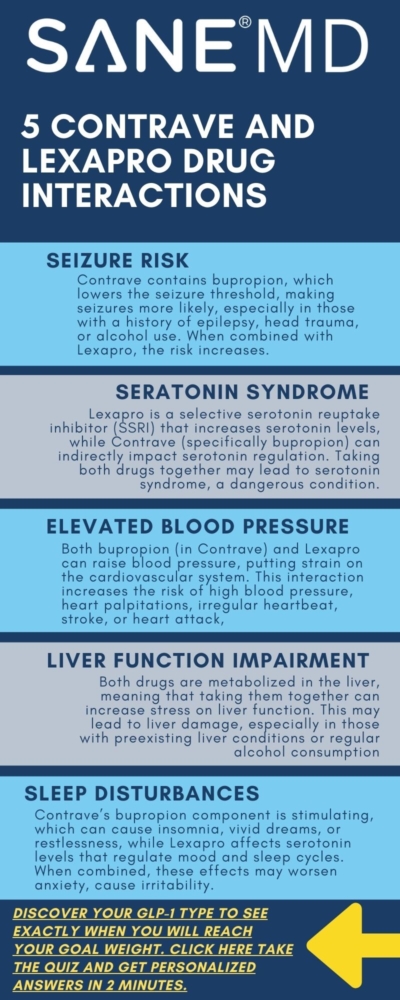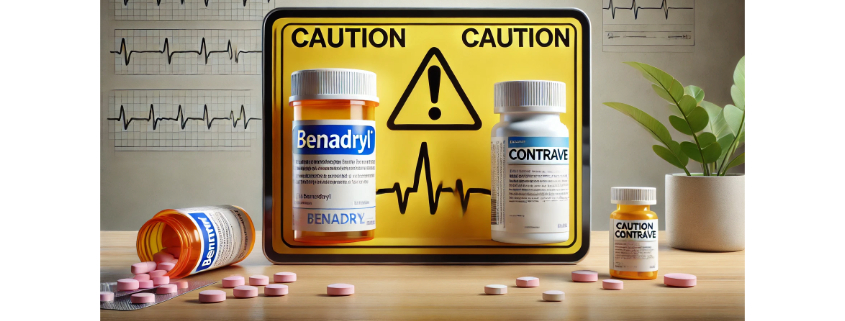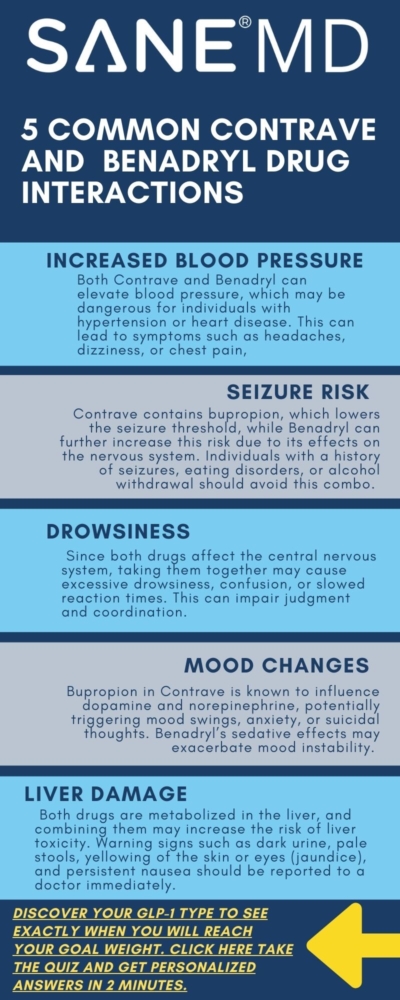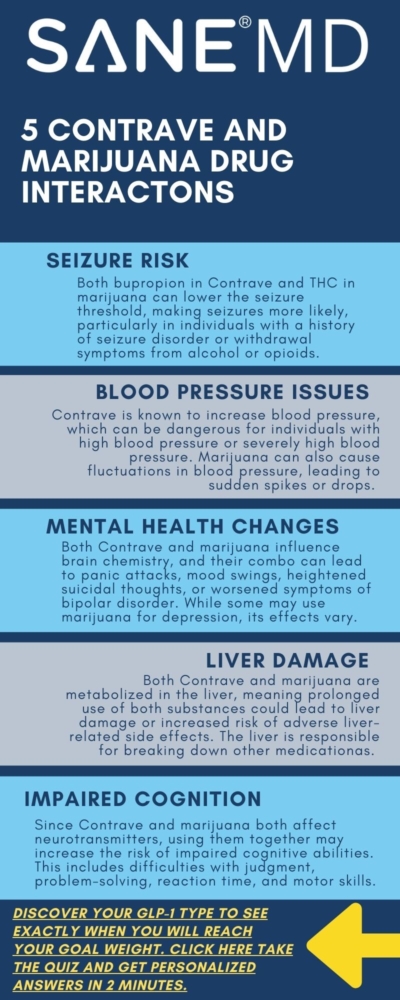Contrave and Lexapro Drug Interactions: Risks & Side Effects

Contrave (bupropion naltrexone) is a weight loss drug, while Lexapro (escitalopram) is commonly prescribed to treat depression and anxiety. When used together, these drugs may interact in ways that increase the risk of severe side effects.
Understanding Contrave and Lexapro drug interactions is essential for patients considering taking Contrave while already on Lexapro or vice versa.
Key Takeaways
- Potential Risks: Taking Contrave and Lexapro together can increase the risk of seizures, serotonin syndrome, and high blood pressure.
- Side Effects: Users may experience chest pain, dry mouth, liver damage, and withdrawal symptoms.
- Medical Supervision: Consulting a healthcare provider before starting Contrave is crucial, especially for those with bipolar disorder, heart disease, or other health conditions.
Understanding Contrave
Contrave (bupropion naltrexone) is a prescription weight loss drug designed to help certain individuals struggling with obesity or weight-related health conditions. It works by affecting brain pathways that regulate appetite and cravings.
The medication consists of two active ingredients: bupropion hydrochloride, which is also used in antidepressants such as Wellbutrin SR, and naltrexone, which is typically prescribed for opioid withdrawal and substance use disorder.
Taking Contrave can increase the risk of side effects, including high blood pressure, liver damage, and risk of seizures. Additionally, Contrave drug interactions are common, and patients should be aware of Contrave and Qsymia together drug interactions when considering weight loss treatments. Patients should disclose all current medications with their healthcare provider before taking Contrave, follow dosage recommendations closely, and avoid high-fat meals, which can affect drug absorption.
Understanding Lexapro
Lexapro (escitalopram) is a selective serotonin reuptake inhibitor (SSRI) used to treat depression and anxiety disorders. It works by increasing serotonin levels in the brain, which helps regulate mood. While effective in treating depression, Lexapro carries risks, including serotonin syndrome, when combined with other drugs that affect serotonin levels, such as Contrave.
Lexapro can also cause side effects such as dry mouth, dizziness, and suicidal thoughts in young adults. Patients should consult their healthcare provider before combining Lexapro with other medications, particularly those that affect the central nervous system.
Contrave and Lexapro Drug Interactions: Risks & Side Effects
| Interaction | Description | Warning Signs |
|---|---|---|
| Increased Risk of Seizures | Contrave (bupropion) lowers seizure threshold, which is worsened when combined with Lexapro. Higher risk for those with a history of seizures, head trauma, or alcohol use. | Twitching, convulsions, loss of consciousness. |
| Blood Pressure and Cardiovascular Risks | Both drugs can elevate blood pressure, increasing the risk of heart attack, stroke, and chest pain. Regular monitoring is required for those with cardiovascular conditions. | Severe headache, dizziness, chest pain, irregular heartbeat. |
| Risk of Serotonin Syndrome | Excessive serotonin activity from Lexapro and indirect serotonin influence of Contrave can lead to serotonin syndrome, causing confusion, rapid heartbeat, fever, and muscle rigidity. | Agitation, excessive sweating, muscle stiffness, hallucinations. |
| Effects on Liver Function | Both drugs stress liver function. Higher risk for individuals with liver disease or those consuming alcohol. Symptoms include jaundice, fatigue, and dark urine. | Yellowing of skin/eyes, abdominal pain, severe fatigue. |
| Gastrointestinal Issues | Increased risk of nausea, vomiting, diarrhea, constipation, and appetite changes due to neurotransmitter effects on digestion. | Severe nausea, persistent vomiting, unpredictable bowel movements. |
| Sleep Disturbances | Contrave’s stimulant effect and Lexapro’s serotonin regulation can cause insomnia, vivid dreams, and daytime fatigue. | Insomnia, nightmares, excessive daytime sleepiness. |
| Mood and Behavioral Changes | Increased anxiety, irritability, paranoia, and hallucinations due to combined neurotransmitter effects. | Rapid mood swings, panic attacks, delusions. |
| Suicidal Thoughts and Depression Worsening | Both medications carry a black box warning for increased suicidal thoughts, especially in young adults and those with mood disorders. | Withdrawal from social interactions, hopelessness, self-harm thoughts. |
| Dizziness and Coordination Issues | Both drugs affect the central nervous system, leading to dizziness, loss of coordination, blurred vision, and eye pain. | Lightheadedness when standing, frequent falls, blurry vision. |
| Increased Risk of High or Low Blood Sugar | Contrave alters blood sugar levels, increasing the risk of hyperglycemia or hypoglycemia, particularly in diabetics. | Shakiness, confusion, excessive thirst, blurred vision. |
| Increased Risk of Accidental Overdose | Confusion, loss of consciousness, seizures, and dangerously high blood pressure may occur if dosages are mismanaged. | Blackouts, tremors, dangerously high blood pressure, stroke risk. |
Understanding Contrave and Lexapro Drug Interactions
Combining Contrave with Lexapro presents multiple risks due to their effects on the central nervous system (CNS) and serotonin levels. Lexapro is a selective serotonin reuptake inhibitor (SSRI), which increases serotonin levels in the brain to help regulate mood. Contrave, which contains bupropion and naltrexone, also affects brain chemistry but in different ways—bupropion influences dopamine and norepinephrine levels, while naltrexone is an opioid antagonist. When deciding if Contrave is right for you, a thorough understanding of all the medications it interacts with is essential to your safety, which is particularly true with Lexapro.
When these two drugs interact, they can lead to serious neurological and cardiovascular complications. The most dangerous risks include serotonin syndrome, increased seizure potential, and heightened blood pressure levels. Individuals taking both medications should be closely monitored by a healthcare provider for any signs of adverse effects.
Contrave and Lexapro drug interactions can include:
1. Increased Risk of Seizures
Certain factors can further increase the likelihood of seizures when taking these medications together, including a history of seizure disorder, alcohol use, or combining Contrave with other medications that lower the seizure threshold, such as Gabapentin. Bupropion, a primary ingredient in Contrave, is known to lower the seizure threshold, making individuals more vulnerable to seizure activity. This effect is exacerbated when combined with Lexapro, which can also affect neurological stability.
Certain factors can further increase the likelihood of seizures when taking these medications together, including:
- A history of seizure disorder or epilepsy
- Head trauma or past concussions
- Brain tumors or neurological diseases
- Excessive alcohol consumption or suddenly stopping alcohol
- Use of other medications that lower the seizure threshold
Individuals at higher risk of seizures should avoid taking Contrave, especially in combination with Lexapro. If a patient experiences twitching, convulsions, or loss of consciousness, they should seek immediate medical attention.
2. Blood Pressure and Cardiovascular Risks
Both bupropion (in Contrave) and Lexapro can increase blood pressure, leading to serious cardiovascular issues. Contrave has been associated with severely high blood pressure, which can escalate the risk of:
- Heart attack
- Chest pain (angina)
- Irregular heartbeat (arrhythmia)
- Stroke
Patients with a history of high blood pressure, heart disease, or other cardiovascular conditions should exercise extreme caution when using Contrave and Lexapro together. Regular blood pressure monitoring is essential for individuals who take both medications.
If a patient experiences severe headaches, dizziness, chest pain, or shortness of breath, they should seek immediate medical attention.
3. Risk of Serotonin Syndrome
Lexapro directly affects serotonin levels by increasing its presence in the brain, while bupropion indirectly impacts serotonin regulation. When combined, these medications may result in serotonin syndrome, a potentially life-threatening condition caused by excessive serotonin activity.
Symptoms of Serotonin Syndrome:
- Agitation or restlessness
- Excessive sweating
- Rapid or irregular heartbeat
- Muscle stiffness or tremors
- Fever or shivering
- Confusion or hallucinations
Serotonin syndrome can progress rapidly, leading to seizures, high fever, and loss of consciousness. If any of these symptoms occur, the individual should stop taking the medication immediately and seek emergency medical care.
4. Effects on Liver Function
Bupropion naltrexone (Contrave) has been associated with liver damage and dysfunction. Since the liver metabolizes both Contrave and Lexapro, taking them together places extra stress on liver function. This risk is heightened in individuals who:
- Have a history of liver disease or liver problems
- Drink alcohol regularly
- Are taking other medications that affect the liver
Signs of Liver Damage:
- Dark urine
- Pale stools
- Yellowing of the skin or eyes (jaundice)
- Severe fatigue
- Abdominal pain
Patients experiencing any of these warning signs should stop taking the medication and seek immediate medical attention. Individuals using Contrave and Lexapro together may need regular liver function tests.
Additional Contrave and Lexapro Interaction Symptoms
1. Gastrointestinal Issues
The combination of Contrave and Lexapro can significantly impact the digestive system, as both medications influence neurotransmitter activity, which in turn affects gut function.

- Nausea and vomiting: This is one of the most common side effects when taking either drug alone, and the risk is further heightened when combined. The nausea may be mild or persistent and can sometimes lead to vomiting, particularly in the early stages of treatment.
- Diarrhea or constipation: Lexapro can cause diarrhea by increasing serotonin levels in the gut, which stimulates motility. Contrave, on the other hand, can contribute to constipation due to its effect on appetite and digestion. This combination may lead to unpredictable bowel habits.
- Loss of appetite: Contrave is designed to suppress appetite for weight loss, while Lexapro can also alter eating patterns. Some individuals may experience a significant decrease in appetite, potentially leading to unintended weight loss.
- Abdominal cramps and bloating: Changes in serotonin levels can trigger gut spasms and bloating, leading to discomfort and gas buildup. Individuals with pre-existing gastrointestinal conditions, such as IBS or acid reflux, may experience exacerbated symptoms.
To manage these digestive side effects, patients should maintain hydration, fiber intake, and balanced meals. If severe nausea or persistent vomiting occurs, a dose adjustment under the supervision of a healthcare provider may be necessary.
2. Sleep Disturbances
Both Contrave and Lexapro influence neurotransmitter activity, which can significantly disrupt sleep patterns.
- Insomnia or trouble falling asleep: Bupropion, one of the main ingredients in Contrave, stimulates the brain, leading to increased energy and difficulty sleeping. When combined with Lexapro, which also affects serotonin balance, sleep disturbances may become more pronounced.
- Vivid dreams or nightmares – Many individuals taking Lexapro report intense and vivid dreams due to increased serotonin activity in the brain. Combining it with Contrave may heighten dream intensity, leading to restless nights or even nightmares.
- Daytime drowsiness or fatigue – While some people experience insomnia, others may feel excessive fatigue during the day, leading to a lack of focus, poor concentration, and reduced energy levels.
To improve sleep quality, patients should:
- Take Contrave earlier in the day to reduce stimulant effects at night.
- Avoid caffeine and high-fat meals in the evening, as they may worsen sleep disturbances.
- Establish a consistent sleep routine with relaxation techniques.
If sleep disturbances become persistent or severe, a healthcare provider may adjust the medication dosage or schedule.
3. Mood and Behavioral Changes
Because both Contrave and Lexapro influence brain chemistry, they can lead to unpredictable emotional and psychological effects.
- Increased anxiety or panic attacks – While Lexapro is intended to reduce anxiety, its interaction with Contrave can trigger excessive restlessness or panic attacks, particularly in individuals sensitive to medication changes.
- Irritability and mood swings – The combination of bupropion (a stimulant) and serotonin regulation can lead to rapid shifts in mood, causing irritability, frustration, or even agitation.
- Hallucinations or paranoia – Although rare, some patients may experience visual or auditory hallucinations due to excessive neurotransmitter stimulation.
- False beliefs (delusions) – A more extreme reaction may include paranoia, irrational thoughts, or delusional thinking, particularly in individuals with a history of bipolar disorder or psychosis.
If these symptoms develop or worsen, immediate consultation with a healthcare provider is necessary. Patients with a history of severe mental health disorders may need alternative treatments.
4. Suicidal Thoughts and Depression Worsening
Both Contrave and Lexapro come with a black box warning for an increased risk of suicidal thoughts, particularly in:
- Young adults under 25 years old
- Individuals with a history of depression or self-harm
- Those experiencing significant mood swings due to medication interactions
Warning Signs to Watch For:
- Sudden withdrawal from social interactions – Becoming uncharacteristically distant, avoiding loved ones, or canceling plans.
- Increased hopelessness or despair – Feeling overwhelmed, excessively sad, or unable to cope with daily tasks.
- Self-harm tendencies – Engaging in dangerous behaviors or expressing thoughts of self-harm.
- Obsessive thoughts about death – Having fixations on mortality, suicide, or feeling “better off dead.”
If any of these symptoms occur, the medication should not be stopped suddenly. Instead, immediate professional intervention is necessary, including contacting a crisis helpline or emergency care provider.
5. Dizziness and Coordination Issues
Since both Contrave and Lexapro affect the central nervous system, they may cause neurological side effects, including:
- Dizziness and lightheadedness: A drop in blood pressure or changes in serotonin levels can cause frequent dizziness, especially when standing up quickly.
- Loss of balance or coordination: Some individuals may feel unsteady on their feet, increasing the risk of falls and accidents.
- Blurred vision: Vision problems, including difficulty focusing or tunnel vision, may occur due to changes in neurotransmitter activity.
- Eye pain or pressure: Increased intraocular pressure may lead to eye pain, headaches, or a risk of developing acute glaucoma.
Until symptoms stabilize, people who experience dizziness should avoid driving, operating machinery, or engaging in physically demanding tasks.
6. Increased Risk of High Blood Sugar or Low Blood Sugar
Contrave can alter blood sugar levels, and when combined with Lexapro, these fluctuations may be unpredictable.
- Episodes of low blood sugar (hypoglycemia) – Shakiness, sweating, confusion, and irritability may occur, particularly in patients with diabetes or those on a low-calorie diet.
- Higher blood sugar levels (hyperglycemia) – Increased thirst, frequent urination, fatigue, and blurred vision can signal blood sugar instability.
Diabetics or individuals at risk of metabolic disorders should closely monitor their blood sugar levels, especially when starting Contrave.
7. Increased Risk of Accidental Overdose
Both Contrave and Lexapro affect brain function, meaning missing doses, doubling up, or miscalculating intake can have serious consequences.
Overdose Symptoms Include:
- Severe confusion or delirium
- Loss of consciousness or blackouts
- Dangerously high blood pressure, leading to stroke risk
- Seizures, tremors, or uncontrollable shaking
If accidental overdose is suspected, call 911 or poison control immediately. Never take an extra dose to make up for a missed one without consulting a healthcare provider.
When to Seek Immediate Medical Attention
Seek urgent medical care if you experience:
- Severe chest pain or irregular heartbeat
- Uncontrollable shaking or seizures
- Fainting or sudden loss of consciousness
- Severe allergic reaction (skin rash, difficulty breathing, swelling of the face/lips/tongue)
- Signs of serotonin syndrome (agitation, hallucinations, muscle twitching, high fever)
Frequently Asked Questions (FAQ)
When considering medications like Contrave and Lexapro, it is crucial to understand potential drug interactions and their effects on your health.
Below are some common questions regarding their use together and with other medications.
Can you take antidepressants with Contrave?
Yes, but with caution. Contrave contains bupropion, which is an atypical antidepressant that affects dopamine and norepinephrine levels. Combining it with other antidepressants, especially SSRIs like Lexapro, can increase the risk of serotonin syndrome, seizures, and high blood pressure.
It is essential to work closely with a healthcare provider when taking antidepressants with Contrave to monitor for potential side effects and ensure a safe treatment plan.
Can I take buPROPion and Lexapro together?
Yes, but this combination requires careful medical supervision. Bupropion (one of the active ingredients in Contrave) and Lexapro both affect brain neurotransmitters but in different ways. While Lexapro increases serotonin levels, bupropion primarily influences dopamine and norepinephrine.
The combination can sometimes be prescribed for individuals who do not respond well to a single antidepressant, but it also comes with a higher risk of seizures, mood instability, and increased anxiety.
Consulting a doctor before combining these medications is crucial to avoid serious side effects.
Can you take weight loss pills with Lexapro?
Some weight loss pills may be safe to take with Lexapro, but many stimulant-based or prescription weight loss drugs can negatively interact with SSRIs. Medications like Contrave, which contain bupropion, carry a higher risk of serotonin syndrome and increased blood pressure when combined with Lexapro.
Over-the-counter weight loss supplements, particularly those containing caffeine, green tea extract, or other stimulants, can also heighten anxiety, heart rate, and insomnia when mixed with Lexapro.
Always consult a healthcare provider before adding a weight loss medication to Lexapro therapy.
What medications should I avoid with Contrave?
Several medications should be avoided while taking Contrave due to potentially dangerous interactions. Monoamine oxidase inhibitors (MAOIs) can lead to life-threatening reactions if taken within 14 days of starting Contrave.
Opioid medications should also be avoided, as naltrexone (a key ingredient in Contrave) blocks opioid effects and can lead to withdrawal symptoms. Seizure medications, some antidepressants, and stimulant-based drugs may increase the risk of seizures or high blood pressure when taken with Contrave.
It is important to disclose all medications to a doctor or pharmacist before starting Contrave to prevent harmful interactions.
Can you take weight loss pills on Lexapro?
Taking weight loss pills while on Lexapro can be risky, depending on the type of pill. Prescription weight loss drugs like Contrave, phentermine, or other stimulant-based medications can increase blood pressure, cause heart palpitations, and worsen anxiety.
Over-the-counter weight loss supplements that contain stimulants, herbal extracts, or metabolism boosters may also lead to insomnia, jitteriness, or serotonin imbalances when combined with Lexapro.
If weight management is a concern, the best approach is to make lifestyle modifications and consult a healthcare provider for safe alternatives.
Conclusion
Understanding the potential risks and interactions between Contrave (bupropion naltrexone) and Lexapro (escitalopram) is crucial for ensuring safe and effective treatment. While both medications serve important functions—Contrave for weight management in compatible individuals and Lexapro for depression and anxiety—their combined use can lead to serious side effects, including seizures, serotonin syndrome, high blood pressure, and liver damage.
Before starting Contrave while taking Lexapro, or vice versa, patients should consult a healthcare provider to evaluate their personal risk factors and determine the best course of action. Regular monitoring for symptoms, including changes in mood, blood pressure levels, and neurological effects, is essential for minimizing complications.
If severe side effects occur, such as chest pain, suicidal thoughts, hallucinations, or signs of serotonin syndrome, immediate medical attention is required. Ensuring open communication with a healthcare provider can help patients safely navigate treatment adjustments and achieve their health goals while reducing the risk of adverse reactions.
For those experiencing concerns related to weight management, depression, or medication interactions, seeking professional medical advice remains the best approach.

Contrave and Benadryl Drug Interactions: Risks & Warnings

Contrave is a prescribed medication for weight loss that combines bupropion and naltrexone to assist compatible individuals in shedding pounds. Benadryl, an over-the-counter antihistamine, is commonly used for allergies, cold symptoms, and sleep issues.
While both drugs serve different purposes, taking Contrave and Benadryl together can result in potentially dangerous drug interactions.
Anyone considering or currently taking Contrave treatment must understand Contrave and Benadryl drug interactions, side effects, and safety warnings.
Key Takeaways
- Combining Contrave and Benadryl may increase the risk of serious side effects, including increased blood pressure, seizures, and mood changes.
- Taking these medications together can lead to dangerous drug interactions, especially in individuals with eating disorders, heart disease, or a history of opioid use.
- Patients should consult their doctor or pharmacist before combining these medications to ensure safety.
How Contrave Works
Contrave is a prescription weight loss medication designed to help certain individuals with obesity or weight-related health conditions manage their weight more effectively.
How Contrave works for weight loss is unique. It combines two active ingredients, bupropion and naltrexone hydrochloride, each of which plays a distinct role in controlling appetite and cravings.
- Bupropion: Originally developed as an antidepressant, bupropion affects the brain’s neurotransmitters, particularly dopamine and norepinephrine. These neurotransmitters regulate mood, motivation, and energy levels, which can influence eating behaviors. Bupropion has also been used as a smoking cessation aid due to its impact on the brain’s reward system. However, it carries a risk of suicidal thoughts, especially in young adults, and can increase the risk of seizures in some individuals.
- Naltrexone Hydrochloride: This opioid antagonist is commonly used in the treatment of opioid dependence and alcohol dependence. In the context of weight loss, it works by blocking opioid receptors in the brain, which are linked to food cravings and emotional eating. By interfering with these reward pathways, naltrexone reduces the pleasure derived from high-calorie foods, making it easier for patients to stick to a healthy diet.
Contrave is a unique weight loss treatment because it combines bupropion and naltrexone hydrochloride. It targets both the psychological and physiological aspects of eating.
However, because of its effects on the brain and nervous system, Contrave comes with potential side effects, including high blood pressure, mood changes, and increased heart rate.
It is also not recommended for individuals with bipolar disorder, seizure disorders, or those taking opioid medications.
Since Contrave is metabolized in the liver, patients with liver damage should consult their doctor before starting treatment.
Additionally, taking high-fat meals while on Contrave can increase the absorption of the drug, potentially leading to stronger side effects.
Patients should tell their doctor about any other medications they are taking to avoid drug interactions that could increase risks or reduce the effectiveness of Contrave treatment.
Understanding Benadryl
Benadryl is an over-the-counter antihistamine widely used for allergy relief, cold symptoms, and as a sleep aid. Its active ingredient, diphenhydramine, is a first-generation antihistamine that works by blocking histamine receptors in the body.
Histamine is a chemical responsible for allergy symptoms such as runny nose, sneezing, watery eyes, and skin rash.
- How It Works: When the body encounters allergens such as pollen, pet dander, or dust mites, it releases histamine, which triggers inflammation and allergy symptoms. By preventing histamine from binding to its receptors, Benadryl reduces nasal congestion, itching, and swelling.
- Sleep Aid Properties: Diphenhydramine has sedative effects, making it a common ingredient in nighttime cold medications and over-the-counter sleep aids. It causes drowsiness by crossing the blood-brain barrier and blocking histamine’s effects in the central nervous system. This can be beneficial for those struggling with insomnia, but it also increases drowsiness, dizziness, and impaired motor coordination.
While Benadryl is generally safe for short-term use, long-term or frequent use can lead to side effects such as dry mouth, urinary retention, memory issues, and confusion. In older adults, prolonged use has been linked to cognitive decline and an increased risk of dementia.
It may also interact negatively with other medications, including opioid pain relievers, muscle relaxants, and alcohol, amplifying their sedative effects.
Patients with high blood pressure, heart disease, glaucoma, or asthma should consult their doctor before taking Benadryl, as it can worsen these conditions.
Additionally, combining Benadryl with other sedatives or central nervous system depressants, such as Contrave, can increase the risk of dizziness, confusion, and serious drowsiness.
Both Contrave and Benadryl affect the brain and nervous system, which is why taking them together should be done with caution and only under medical supervision.
Contrave and Benadryl Drug Interactions: Risks & Recommendations
| Interaction Factor | Effects | Risk Level | Recommendation |
|---|---|---|---|
| Seizure Risk | Both Contrave and Benadryl lower the seizure threshold, increasing risk. | High | Avoid combining if you have a seizure disorder or history of seizures. |
| Blood Pressure Changes | May cause high blood pressure or fluctuations, leading to cardiovascular issues. | Moderate to High | Monitor blood pressure closely; consult a doctor before use. |
| Mental Health Risks | Potential for mood changes, depression, panic attacks, and suicidal thoughts. | High | Patients with depression, bipolar disorder, or mood disorders should consult a doctor. |
| Blood Sugar Levels | May cause low blood sugar or sudden fluctuations, especially in diabetics. | Moderate | Diabetics should monitor blood sugar closely and discuss with a doctor. |
| Liver Damage | Both drugs are metabolized in the liver, increasing liver damage risk. | High | Patients with liver conditions should get routine liver function tests. |
| Allergic Reactions | Increases likelihood of serious allergic reactions, such as rash or anaphylaxis. | High | Seek immediate medical attention for rash, swelling, or breathing issues. |
| Cognitive Impairment | Can cause drowsiness, confusion, memory problems, and dizziness. | Moderate | Avoid activities requiring alertness; use caution in elderly patients. |
| Heart Health Risks | May contribute to irregular heartbeat, chest pain, or increased heart rate. | High | Heart patients should consult their doctor and monitor symptoms closely. |
| Impact on Weight Loss | Benadryl may counteract Contrave’s effects by increasing drowsiness and slowing metabolism. | Moderate to High | Consult a doctor before combining to ensure weight loss treatment remains effective. |
Potential Drug Interactions
Combining Contrave and Benadryl can lead to serious drug interactions, affecting blood pressure, mental health, and other critical functions.
Taking these medications together may increase the risk of seizures, cause mood changes, and affect cognitive abilities.
In addition to Benadryl, Contrave may also interact with other medications, such as antidepressants like Lexapro. Learn more about the potential risks of Contrave and Lexapro drug interactions in our comprehensive guide.
It’s crucial to inform your doctor about all the medications you are currently taking before beginning Contrave treatment.
Risk of Seizures
Both bupropion in Contrave and diphenhydramine in Benadryl can lower the seizure threshold, increasing the risk of seizures.
Individuals with a history of seizures, eating disorders, or alcohol use should avoid combining these medications.
Tell your doctor if you are at risk of seizures before taking Contrave.
Effects on Blood Pressure
Taking Contrave and Benadryl together may lead to high blood pressure or fluctuations in blood pressure levels. High blood pressure can increase the risk of heart disease, heart attack, or stroke.
Patients with preexisting heart disease or hypertension should consult their doctor immediately before using these medications.
Mental Health Risks
Combining Contrave and Benadryl may result in mood changes, depression, panic attacks, or even suicidal thoughts. Bupropion is known to affect mental health, and when combined with Benadryl, the risk of serious mental health side effects may increase.
Patients with a history of depression, bipolar disorder, or mood disorders should exercise caution and tell their doctor about any changes.
Impact on Blood Sugar Levels
Contrave can affect blood sugar levels, and individuals with diabetes should monitor their blood sugar closely when taking this medication.
Adding Benadryl to the mix may increase the risk of low blood sugar or sudden changes in blood sugar control.
Patients should discuss possible interactions with their healthcare provider.
Liver Damage and Gastrointestinal Issues
Both Contrave and Benadryl are metabolized in the liver, increasing the risk of liver damage. Symptoms such as dark urine, pale stools, or abdominal pain may indicate liver problems and should prompt medical attention.
Individuals with a history of liver issues should tell their doctor before starting treatment.
Allergic Reactions and Skin Reactions
Using Contrave and Benadryl together can increase the risk of serious allergic reactions, such as a skin rash, serious skin reactions, or Stevens-Johnson syndrome. Signs of a serious allergic reaction include swelling, difficulty breathing, or severe skin reactions.
Patients should seek medical attention if they experience these symptoms.
Cognitive and Neurological Effects
Combining these drugs can impair cognitive function, causing drowsiness, confusion, or impaired judgment. Patients should avoid driving or operating heavy machinery if they experience these side effects.
The risk of neurological issues increases if alcoholic beverages are consumed while taking these medications.
Effects on Heart Health
Taking Contrave and Benadryl together can increase the risk of an irregular heartbeat, high blood pressure, or chest pain.
Patients with heart disease should monitor for symptoms like chest pain or heart palpitations and consult a doctor immediately if they occur.
Impact on Weight Loss Treatment
Benadryl may counteract some of the weight loss effects of Contrave by increasing drowsiness and slowing metabolism. Patients taking Contrave for weight loss should avoid using Benadryl unless absolutely necessary.
It’s important to tell your doctor if you’re using over-the-counter medications while on Contrave treatment.
Risk of Opioid Withdrawal
Since Contrave contains naltrexone hydrochloride, patients using opioids or those with a history of opioid use should avoid combining it with Benadryl.
The combination could increase the risk of opioid withdrawal symptoms, leading to serious health risks.
Impact on Liver Function
Long-term use of Contrave and Benadryl can increase the risk of liver damage. Symptoms such as dark urine, pale stools, or abdominal pain should be reported to a doctor immediately.
Patients with liver conditions should undergo routine liver function tests.
Serious Skin Reactions
Combining these drugs may increase the risk of serious skin reactions. Symptoms include a severe skin rash, Stevens-Johnson syndrome, or other life-threatening skin conditions.
Patients should seek immediate medical attention if they experience signs of a serious skin reaction.
Symptoms Requiring Immediate Medical Attention
Patients taking Contrave and Benadryl should be aware of serious side effects that require immediate medical attention.
While some side effects may be mild or temporary, others can indicate a life-threatening reaction or severe complications that should not be ignored.

- Chest Pain: If you experience chest pain, tightness, or pressure, it could indicate a heart attack, irregular heartbeat, or high blood pressure complications. This is particularly concerning for individuals with a history of heart disease, high blood pressure, or cardiovascular issues. Seek emergency medical care if chest pain is severe or accompanied by shortness of breath, dizziness, or sweating.
- Severe Abdominal Pain: Persistent or intense abdominal pain may signal gastrointestinal issues, liver damage, or a serious allergic reaction. Patients taking Contrave should be especially cautious, as naltrexone hydrochloride can affect liver function, increasing the risk of liver inflammation or damage.
- Dark Urine and Pale Stools: These symptoms may indicate liver dysfunction, gallbladder disease, or bile duct obstruction. Since both Contrave and Benadryl are processed through the liver, their combined use may increase the risk of liver damage over time. If you notice dark urine, pale stools, or yellowing of the skin or eyes (jaundice), seek medical attention immediately.
- Serious Allergic Reaction: Symptoms of a serious allergic reaction (anaphylaxis) can include swelling of the face, lips, tongue, or throat, difficulty breathing, hives, and a severe skin rash. Anaphylaxis is a life-threatening condition that requires immediate emergency care. Individuals with a history of allergic reactions to medications should be particularly cautious when taking Contrave and Benadryl together.
If you experience sudden changes in health while taking these medications, do not wait—contact a doctor immediately or seek emergency medical care.
Side Effects to Watch
While Contrave and Benadryl are effective for their intended uses, combining them may lead to side effects that impact physical and mental well-being.
These can range from mild discomfort to serious health risks requiring medical intervention.
Common Side Effects
- Drowsiness and Dizziness: Since both Benadryl and Contrave affect the central nervous system, they can cause excessive drowsiness, dizziness, and impaired coordination. This increases the risk of falls, accidents, and difficulty performing daily tasks.
- Dry Mouth and Dehydration: Diphenhydramine in Benadryl and bupropion in Contrave can lead to dry mouth, making it uncomfortable to eat or speak. Staying hydrated and using sugar-free lozenges may help alleviate this symptom.
- Joint Pain and Muscle Aches: Some patients report joint pain or muscle discomfort when taking Contrave. This may worsen when combined with Benadryl, especially in individuals prone to chronic pain or inflammatory conditions.
- Cognitive Impairment: Confusion, memory problems, and difficulty concentrating are possible when taking these medications together. Older adults should be particularly cautious, as long-term Benadryl use has been linked to cognitive decline and an increased risk of dementia.
Serious Side Effects
- Suicidal Thoughts or Mood Changes: Bupropion, one of the active ingredients in Contrave, can increase the risk of suicidal thoughts, mood swings, and depression, particularly in young adults. Combining it with Benadryl may exacerbate mood disturbances, anxiety, or panic attacks. If you experience suicidal thoughts, sudden changes in mood, or worsening depression, contact a doctor immediately.
- Liver Damage: Since both medications are processed in the liver, their combined use may increase the risk of liver toxicity. Symptoms such as dark urine, pale stools, fatigue, nausea, and jaundice may indicate liver damage and require prompt medical evaluation.
- Irregular Heartbeat and High Blood Pressure: Patients with high blood pressure, heart disease, or a history of cardiovascular conditions should be particularly careful, as Contrave can increase blood pressure and heart rate. Taking Benadryl may further contribute to irregular heartbeat, palpitations, or chest discomfort. If you notice any unusual heart symptoms, seek medical attention.
When to Contact a Doctor
If you experience any persistent or worsening Contrave side effects, it is essential to tell your doctor as soon as possible. Always consult a doctor or pharmacist before taking new medications to prevent possible interactions and increased risk of severe complications.
FAQ: Contrave and Benadryl Drug Interactions
Understanding the possible interactions between Contrave and other medications, including Benadryl, is essential for ensuring safety and effectiveness. Certain drug combinations can lead to serious side effects, including increased risk of seizures, cardiovascular issues, and mood disturbances.
Below are answers to commonly asked questions regarding Contrave, Benadryl, and their potential interactions.
1. What medications should not be taken with Contrave?
Several medications should be avoided while taking Contrave due to potential Contrave drug interactions. These include monoamine oxidase inhibitors (MAOIs), which can increase the risk of high blood pressure and serotonin syndrome if taken within 14 days of starting Contrave.
Opioid medications should also be avoided, as Contrave contains naltrexone, an opioid antagonist that can cause withdrawal symptoms. Additionally, other medications that lower the seizure threshold, such as antipsychotics, certain antidepressants, and corticosteroids, may increase the risk of seizures.
Always tell your doctor about any medications you are taking before starting Contrave treatment.
2. Can I take Benadryl while on buPROPion?
It is generally not recommended to take Benadryl while on buPROPion, as both drugs can lower the seizure threshold, increasing the risk of seizures.
Diphenhydramine, the active ingredient in Benadryl, may also cause drowsiness and cognitive impairment, which can be exacerbated when taken with buPROPion. Additionally, both medications may affect mood and mental health, potentially leading to an increased risk of panic attacks or mood swings.
If you need an antihistamine while taking buPROPion, consult your doctor or pharmacist for a safer alternative.
3. What drugs interact badly with Benadryl?
Benadryl can interact negatively with several medications, including sedatives, muscle relaxants, and other central nervous system depressants, leading to excessive drowsiness and impaired coordination. It can also interact with monoamine oxidase inhibitors (MAOIs), increasing the risk of high blood pressure and other side effects.
Taking Benadryl with other medications that have anticholinergic effects, such as certain antidepressants and bladder medications, can increase the risk of dry mouth, urinary retention, and confusion.
People with heart disease or high blood pressure should also exercise caution, as Benadryl may cause irregular heartbeat or increased blood pressure.
Always consult a healthcare provider before combining Benadryl with other medications.
4. Does naltrexone block Benadryl?
Naltrexone does not block the effects of Benadryl. Naltrexone is an opioid antagonist that primarily affects opioid receptors, whereas Benadryl (diphenhydramine) is an antihistamine that works on histamine receptors.
However, both medications can affect the central nervous system, potentially leading to increased drowsiness or dizziness when taken together.
Although naltrexone does not interfere with the effectiveness of Benadryl, individuals taking Contrave, which contains naltrexone, should still consult their doctor before using Benadryl to avoid potential interactions or heightened side effects.
5. What medications should not be taken with Contrave?
Contrave should not be taken with opioid medications, as it contains naltrexone, which can block opioid effects and lead to withdrawal symptoms in individuals dependent on opioids. Therefore, Contrave and Oxycodone drug interactions can be dangerous, so you should never take them together unless directed to do so by your healthcare provider.
Additionally, medications that lower the seizure threshold, such as certain antidepressants (e.g., SSRIs, SNRIs, tricyclics), stimulants, and antipsychotics, may increase the risk of seizures when combined with Contrave.
High-fat meals should also be avoided, as they can increase the absorption of Contrave, potentially leading to stronger side effects.
Always tell your doctor about any prescription, over-the-counter, or herbal medications you are taking before starting Contrave treatment.
Conclusion
Combining Contrave and Benadryl can lead to serious health risks, including seizures, high blood pressure, and severe allergic reactions.
Patients should tell their doctor or pharmacist about all medications they are taking before starting Contrave treatment. Monitoring for side effects and consulting a healthcare provider for medical guidance is essential to ensure safety.
By understanding the risks and warnings associated with Contrave and Benadryl drug interactions, individuals can make informed decisions about their treatment options and minimize the risk of life-threatening complications.

Contrave and Marijuana Drug Interactions: Risks & Safety

Contrave is a prescription weight loss medication that combines bupropion and naltrexone to help compatible individuals manage obesity. However, patients using Contrave may also use marijuana, either recreationally or medicinally, raising concerns about possible drug interactions. The combined effects of these substances on the brain and body could pose significant health risks.
Understanding Contrave and marijuana drug interactions is critical for those considering if Contrave is the right fit for their weight loss journey.
Key Takeaways
- Drug Interactions: The combination of Contrave and marijuana may increase the risk of seizures, impact blood pressure, and alter the effects of other medications.
- Potential Health Risks: Taking Contrave while using marijuana could lead to serious side effects, including changes in mental health, increased heart rate, and impaired cognitive function.
- Medical Guidance: Patients should consult a doctor or pharmacist before using Contrave alongside marijuana to avoid adverse effects and ensure safety.
Understanding Contrave and Its Effects
Contrave is prescribed as an aid for weight loss in certain individuals with obesity or weight-related health conditions.
It contains two active ingredients:
- Bupropion: An antidepressant that can also help with smoking cessation and weight management. However, it carries a risk of seizures and has a boxed warning alerting doctors about potential suicidal thoughts.
- Naltrexone: An opioid antagonist used in treating opioid dependence and alcohol dependence. It blocks opioid receptors, helping to reduce food cravings but also impacting pain relief for those on opioid medications.
But what does Contrave do, especially when used with marijuana? The combination of these substances requires careful medical supervision due to the increased risk of side effects, particularly for individuals with preexisting health conditions such as high blood pressure, seizure disorder, or mental health conditions like bipolar disorder.
Contrave and Marijuana Drug Interactions: Risks & Recommendations
| Category | Impact | Recommendation |
|---|---|---|
| Seizure Risk | Both Contrave and marijuana can lower the seizure threshold, increasing the risk of seizures. | Avoid combining these substances if prone to seizures; consult a healthcare provider. |
| Blood Pressure Fluctuations | Marijuana can cause fluctuations in blood pressure, while Contrave can increase it, leading to cardiovascular risks. | Monitor blood pressure closely; avoid marijuana if taking blood pressure medications. |
| Mental Health Changes | Combination may heighten suicidal thoughts, panic attacks, and mood swings, especially in individuals with bipolar disorder. | Seek medical advice before use, particularly if prone to anxiety, depression, or mood disorders. |
| Liver Damage | Both substances are metabolized in the liver, increasing the risk of liver damage over time. | Individuals with liver conditions should avoid combining these substances; routine liver tests recommended. |
| Impaired Cognitive Function | Neurotransmitter effects may impair judgment, coordination, and reaction time. | Avoid driving or operating heavy machinery when using either substance. |
| Increased Blood Pressure | Both substances may contribute to dizziness, headaches, and cardiovascular complications. | Monitor cardiovascular health and limit other stimulants like caffeine and nicotine. |
| Impaired Drug Effects | Marijuana can interfere with how other medications, including beta blockers, function in the body. | Consult a doctor or pharmacist before combining these substances. |
| Gastrointestinal Issues | Marijuana and Contrave can both affect digestion, causing nausea, vomiting, or irregular absorption of extended-release tablets. | If digestive discomfort occurs, assess whether marijuana may be contributing to the issue. |
Marijuana’s Impact on the Body and Drug Interactions
Marijuana contains compounds like THC and CBD, which interact with the brain’s endocannabinoid system. While some individuals use marijuana to treat depression or anxiety, its effects on cognition, heart rate, and blood pressure can create complications when combined with other medications.
Potential Drug Interactions
Using marijuana alongside Contrave could lead to certain drug interactions that may increase the risk of adverse effects. Both substances impact the brain, cardiovascular system, and liver, and their combined effects may heighten risks for some individuals. Contrave contains bupropion, which influences dopamine and norepinephrine levels, and naltrexone, which blocks opioid receptors. Marijuana affects the endocannabinoid system, which plays a role in mood, cognition, and cardiovascular function.
The interaction between these substances can lead to unpredictable side effects, requiring careful consideration before using them together.
Seizure Risk
Both bupropion in Contrave and THC in marijuana can lower the seizure threshold, making seizures more likely, particularly in individuals with a history of seizure disorder or withdrawal symptoms from alcohol or opioids. The risk of seizures is especially concerning for individuals taking higher doses of Contrave or using marijuana frequently.
Patients with epilepsy or those prone to seizures should avoid this combination unless specifically advised by a healthcare provider.
Blood Pressure Fluctuations
Contrave is known to increase blood pressure, which can be dangerous for individuals with high blood pressure or severely high blood pressure. Marijuana can also cause fluctuations in blood pressure, leading to sudden spikes or drops that may result in dizziness, fainting, or an increased risk of side effects.
If a person is taking blood pressure medications or has a history of heart disease, mixing Contrave with marijuana could worsen cardiovascular risks. Regular blood pressure monitoring is recommended for anyone using this combination.
Mental Health Changes
Both Contrave and marijuana influence brain chemistry, and their combination can lead to panic attacks, mood swings, heightened suicidal thoughts, or worsened symptoms of bipolar disorder. While some individuals use marijuana to treat depression, its effects vary depending on the strain, dosage, and individual brain chemistry.
Marijuana’s impact on mental health conditions can be unpredictable, and when paired with Contrave, it may increase the risk of severe psychiatric symptoms. Individuals with a history of mental health changes or tricyclic antidepressant use should exercise caution when using these substances together.
Liver Damage
Both Contrave and marijuana are metabolized in the liver, meaning prolonged use of both substances could lead to liver damage or increased risk of adverse liver-related side effects. The liver is responsible for breaking down other medications, and the interaction between Contrave and marijuana may slow down or accelerate the metabolism of certain medications. This can lead to higher-than-intended drug concentrations in the bloodstream, increasing toxicity risks.
Patients with preexisting liver conditions or those taking other drugs that affect liver function should avoid combining these substances.
Impaired Cognitive Function
Since Contrave and marijuana both affect neurotransmitters, using them together may increase the risk of impaired cognitive abilities. This includes difficulties with judgment, problem-solving, reaction time, and motor skills.
Individuals who drive, operate heavy machinery, or perform tasks requiring focus should avoid using these substances together, as they may experience slowed reflexes, memory issues, and poor decision-making. The risk of side effects such as confusion or drowsiness increases with higher doses of marijuana or Contrave.
Risks and Side Effects of Mixing Contrave and Marijuana
The risk of Contrave side effects significantly increases when Contrave and marijuana are taken together, particularly in individuals with health conditions that make them more susceptible to adverse drug interactions. These side effects can range from mild discomfort to severe health complications requiring medical attention.
Understanding the potential risks can help individuals make informed decisions about their medication use.

Increased Blood Pressure
Since both substances can increase blood pressure, individuals may experience symptoms such as dizziness, headaches, heart palpitations, and shortness of breath. This can be especially concerning for those with severely high blood pressure or a history of cardiovascular disease.
If left unchecked, this combination may lead to an increased risk of heart attack or stroke in susceptible individuals. Monitoring blood pressure regularly and avoiding additional stimulants like caffeine or nicotine can help minimize the risks.
Mental Health Changes
Contrave has been associated with suicidal thoughts, and marijuana use may intensify symptoms of depression, anxiety, or paranoia. Individuals with a history of bipolar disorder or those taking other antidepressants may experience increased mood instability when combining these substances.
Since Contrave affects dopamine and norepinephrine levels, and marijuana influences serotonin and cannabinoid receptors, the interaction between the two could worsen preexisting mental health conditions.
Those with a history of mental health changes should speak to a doctor before using marijuana while on Contrave.
Impaired Drug Effects
Marijuana can interfere with the effectiveness of other medications, including certain beta blockers, making it challenging to manage blood pressure, heart rate, or anxiety symptoms. Additionally, the way Contrave interacts with marijuana may alter its weight loss effects, making it less effective at reducing cravings or appetite.
Individuals on weight loss drugs should be mindful that marijuana use could counteract their treatment goals. A doctor or pharmacist should be consulted to determine whether adjustments need to be made to medication dosages.
Gastrointestinal Issues
Both Contrave and marijuana can affect the digestive system, and their combination may increase the risk of nausea, vomiting, or stomach discomfort. Extended-release tablets of Contrave are designed to be absorbed gradually, but when taken with marijuana—particularly edible cannabis—digestive processes may slow down, potentially leading to inconsistent absorption.
This could result in unpredictable drug levels, causing fluctuations in appetite, metabolism, and overall effectiveness of the medication. Individuals who experience frequent gastrointestinal issues while using Contrave should consider whether marijuana may be contributing to their discomfort.
By understanding these risks and side effects, individuals can make safer choices regarding their use of Contrave and marijuana. Consulting a healthcare provider before combining these substances is highly recommended to ensure Contrave treatment remains effective and does not increase the risk of severe complications.
Who Is at the Highest Risk?
Certain individuals may be more vulnerable to Contrave drug interactions with marijuana, including those who:
- Have a seizure disorder or a history of opioid withdrawal symptoms
- Are prescribed weight loss drugs or other medications that affect serotonin or dopamine levels
- Have eating disorders, as both Contrave and marijuana can impact appetite regulation
- Suddenly stop drinking alcohol, as Contrave already carries risks for individuals with a history of alcohol dependence
- Are taking tricyclic antidepressants, which could interact with both substances
The Role of Medical Supervision
Before starting Contrave treatment, individuals should discuss their medical history and lifestyle habits, including marijuana use, with their healthcare provider.
A doctor or pharmacist can help determine whether the combination is safe and whether adjustments need to be made to existing treatments.
What to Discuss With Your Doctor:
- Any preexisting health history, including mental health conditions
- Use of related drugs, over-the-counter medications, or certain medications that might interact with Contrave
- The possibility of alternative weight loss drugs if Contrave poses risks
Healthcare providers may also recommend additional lab tests to monitor liver function and detect potential drug interactions.
Special Considerations for Women
Women taking Contrave should be especially cautious if they are pregnant, nursing, or planning to become pregnant. The drug can pass into breast milk and potentially affect an infant’s health.
Additionally, marijuana use during pregnancy is not recommended due to its impact on fetal brain development.
Emergency Situations and Adverse Reactions
In rare cases, a medical emergency may arise from severe interactions between Contrave and marijuana.
Symptoms requiring immediate attention include:
- Severe nausea, vomiting, or signs of liver damage
- Chest pain or dangerously high blood pressure
- Extreme confusion or mental health changes
- Difficulty breathing or an allergic reaction
If a person experiences a severe reaction, they should contact their local emergency number or seek help from a poison control center.
FAQ: Contrave and Marijuana Drug Interactions
When taking Contrave, understanding potential drug interactions is essential to ensure safety and effectiveness. Marijuana, whether used recreationally or medicinally, can affect how medications work in the body, raising concerns about its compatibility with Contrave and other prescription drugs.
This FAQ section addresses common questions about Contrave, its interactions with marijuana, and other important considerations. If you are currently taking Contrave or planning to use it alongside other substances, consulting a healthcare provider is always recommended.
1. What medications should not be taken with Contrave?
Certain medications can interact with Contrave, leading to increased risks of side effects or reduced effectiveness. Contrave should not be taken with opioid-containing medications, as it contains naltrexone, an opioid antagonist that can cause withdrawal symptoms in individuals with opioid dependence. Additionally, Contrave should not be taken with certain antihistamines, like Benadry, as Contrave and Benadryl drug interactions can occur.
Additionally, drugs that lower the seizure threshold, such as certain antidepressants, antipsychotics, or stimulants, may increase the risk of seizures when combined with Contrave. Blood pressure medications, certain beta blockers, and other drugs affecting dopamine and norepinephrine levels should also be used with caution.
Always consult a doctor or pharmacist before combining Contrave with other medications.
2. Does marijuana interact with any medication?
Marijuana can interact with various medications, potentially altering their effectiveness or increasing the risk of adverse effects. THC and CBD, the primary compounds in marijuana, affect liver enzymes responsible for drug metabolism, which can slow down or speed up how certain medications are processed.
Marijuana can enhance the sedative effects of central nervous system depressants, such as benzodiazepines and opioids, increasing the risk of drowsiness, dizziness, or respiratory depression. It may also interact with blood thinners, antidepressants, and medications that affect heart rate and blood pressure.
If you are taking prescription drugs, it is essential to discuss marijuana use with a healthcare provider to avoid unwanted interactions.
3. Does marijuana interact with Ozempic?
There is limited research on direct interactions between marijuana and Ozempic, a medication used for managing Type 2 diabetes and weight loss. However, marijuana can affect blood sugar levels, which could interfere with Ozempic’s effectiveness in regulating glucose.
Some users experience increased appetite from THC, potentially counteracting Ozempic’s appetite-suppressing effects, while CBD may contribute to lowering blood sugar. Additionally, because both substances can cause nausea in some individuals, using them together might increase the likelihood of gastrointestinal discomfort.
Patients using Ozempic should monitor their blood sugar levels closely and consult their doctor before using marijuana.
4. Does Contrave work for smoking?
Contrave is not specifically approved for smoking cessation, but it contains bupropion, an active ingredient in the smoking cessation drug Zyban. Bupropion helps reduce nicotine cravings and withdrawal symptoms, which may make quitting smoking easier for some individuals. However, Contrave also includes naltrexone, which is primarily used for weight management and opioid or alcohol dependence rather than smoking cessation.
While some patients may experience reduced cravings for cigarettes while on Contrave, it is not a first-line treatment for quitting smoking. If smoking cessation is a goal, a doctor may recommend Zyban or other proven smoking cessation therapies.
5. What to avoid while on Contrave?
Certain substances and behaviors should be avoided while taking Contrave to minimize risks and maximize effectiveness. Drinking alcohol, particularly in large amounts, should be avoided because it may increase the likelihood of seizures and worsen side effects like dizziness or nausea. High-fat foods should also be limited, as they can increase the absorption of Contrave, potentially leading to higher blood levels and increased side effects.
Patients should be cautious with other medications, including opioids, as naltrexone in Contrave can block their effects and cause withdrawal. Additionally, using marijuana or other central nervous system depressants may heighten drowsiness, mood changes, or cardiovascular risks.
Consulting a healthcare provider before adding or stopping any medication is essential while taking Contrave.
Conclusion
Combining Contrave with marijuana presents potential risks due to certain drug interactions affecting blood pressure, seizure risk, and mental health. Those taking Contrave should consult a doctor or pharmacist before using marijuana to avoid complications. Following professional medical advice is essential to increase the chances of successful weight management while minimizing adverse effects.


